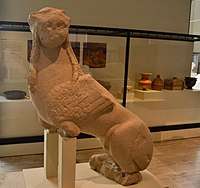Sphinx of Agost
The Sphinx of Agost is a Greek-influenced Iberian limestone sculpture,[1] dated from the late sixth century BCE, that was found in the Agost reservoir in Alicante, Spain, in 1893.

Sphinx of Agost
The badly damaged statue is 82 cm high and represents a sphinx with the head of a woman, body of a winged lion and tail of a snake. This particular sphinx may have been included in an Iberian tomb to carry the soul of the deceased to the afterlife.
The Sphinx of Agost is on display at the National Archaeological Museum (Madrid).
Notes
- Greeks in Iberia:Colonialism without Colonization, Adolfo J. Dominguez, The Archaeology of Colonialism, ed. Claire L. Lyons, John K. Papadopoulos, (Getty Research Institute, 2002), 74.
gollark: *checks TCAP*
gollark: They vanish fast.
gollark: Missed a silver.
gollark: I briefly mistook it for a blusang lindwyrm.
gollark: BLUE starsingers? Cool!
This article is issued from Wikipedia. The text is licensed under Creative Commons - Attribution - Sharealike. Additional terms may apply for the media files.